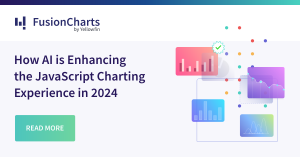This is the fourth post in our series ‘Principles of Data Visualization’ #PoDV
For the past few weeks, we’ve been discussing the goals of data visualization as well as how our eyes and brain process visual information. We’ll go beyond the physical process this week to learn about the fundamentals of visual processing.
In this post, we’ll teach you about the most fundamental building blocks of a visualization: Preattentive Attributes and how we decode visual information. If you’re looking for a Data Visualization Tool, we recommend FusionCharts for data visualization when decoding visual information.
 Image credit: Colin Ware, Information Visualization: Perception for Design
These attributes come into play when we analyze any visual. Of this list, only 2-D Position, and Line Length can be used to perceive quantitative data with precision. The other attributes are useful for perceiving other types of data such as categorical, or relational data. For example, both the pie chart and the bar chart below show the same data. But you can’t easily tell from the pie chart which is the biggest slice of the pie. That’s more clearly visible in the bar chart as it calls on the preattentive attribute of length.
Image credit: Colin Ware, Information Visualization: Perception for Design
These attributes come into play when we analyze any visual. Of this list, only 2-D Position, and Line Length can be used to perceive quantitative data with precision. The other attributes are useful for perceiving other types of data such as categorical, or relational data. For example, both the pie chart and the bar chart below show the same data. But you can’t easily tell from the pie chart which is the biggest slice of the pie. That’s more clearly visible in the bar chart as it calls on the preattentive attribute of length.
 Considering preattentive attributes can help when deciding which chart type to use for our data. While preattentive attributes are what we immediately identify in a visual, they aren’t the only things we notice. We go on to form analytical patterns.
Considering preattentive attributes can help when deciding which chart type to use for our data. While preattentive attributes are what we immediately identify in a visual, they aren’t the only things we notice. We go on to form analytical patterns.
 Image credit: Stephen Few, Now You See It: Simple Visualization Techniques for Quantitative Analysis
These patterns are an intrinsic part of our vision, and are frequently used when we analyze and describe a chart. However, as a word of caution, we are hard-wired to look for patterns in any visual information we notice. Sometimes we do this even when there isn’t an apparent connection or pattern in the visual. To avoid this, it helps to know the various patterns and have a wide vocabulary to work with visuals. This will allow us to consider multiple options before concluding on the most prominent pattern in a visual.
If you’d like to know more on this topic, get our white paper ‘Principles of Data Visualization’. Stay tuned next week as we bring this series to a close with the important Gestalt principles.
Image credit: Stephen Few, Now You See It: Simple Visualization Techniques for Quantitative Analysis
These patterns are an intrinsic part of our vision, and are frequently used when we analyze and describe a chart. However, as a word of caution, we are hard-wired to look for patterns in any visual information we notice. Sometimes we do this even when there isn’t an apparent connection or pattern in the visual. To avoid this, it helps to know the various patterns and have a wide vocabulary to work with visuals. This will allow us to consider multiple options before concluding on the most prominent pattern in a visual.
If you’d like to know more on this topic, get our white paper ‘Principles of Data Visualization’. Stay tuned next week as we bring this series to a close with the important Gestalt principles.
Preattentive Attributes Used by Our Working Memory
Colin Ware, a data visualization expert, wrote a book ‘Information Visualization’ in which he terms the basic building blocks of the visualization process as ‘Preattentive’ attributes. These attributes are what immediately catch our eye when we look at visualization. They can be perceived in less than 10 milliseconds, even before we make a conscious effort to notice them. Here’s a list of the preattentive attributes: Image credit: Colin Ware, Information Visualization: Perception for Design
These attributes come into play when we analyze any visual. Of this list, only 2-D Position, and Line Length can be used to perceive quantitative data with precision. The other attributes are useful for perceiving other types of data such as categorical, or relational data. For example, both the pie chart and the bar chart below show the same data. But you can’t easily tell from the pie chart which is the biggest slice of the pie. That’s more clearly visible in the bar chart as it calls on the preattentive attribute of length.
Image credit: Colin Ware, Information Visualization: Perception for Design
These attributes come into play when we analyze any visual. Of this list, only 2-D Position, and Line Length can be used to perceive quantitative data with precision. The other attributes are useful for perceiving other types of data such as categorical, or relational data. For example, both the pie chart and the bar chart below show the same data. But you can’t easily tell from the pie chart which is the biggest slice of the pie. That’s more clearly visible in the bar chart as it calls on the preattentive attribute of length.
 Considering preattentive attributes can help when deciding which chart type to use for our data. While preattentive attributes are what we immediately identify in a visual, they aren’t the only things we notice. We go on to form analytical patterns.
Considering preattentive attributes can help when deciding which chart type to use for our data. While preattentive attributes are what we immediately identify in a visual, they aren’t the only things we notice. We go on to form analytical patterns.
Forming Analytical Patterns Out of Preattentive Attributes
If preattentive attributes are the alphabets of visual language, analytical patterns are the words we form using them. We immediately identify the preattentive attributes in a visualization. We then combine the preattentive attributes to seek out analytical patterns in the visual. Here are the basic analytical patterns that we identify when looking at a visual: Image credit: Stephen Few, Now You See It: Simple Visualization Techniques for Quantitative Analysis
These patterns are an intrinsic part of our vision, and are frequently used when we analyze and describe a chart. However, as a word of caution, we are hard-wired to look for patterns in any visual information we notice. Sometimes we do this even when there isn’t an apparent connection or pattern in the visual. To avoid this, it helps to know the various patterns and have a wide vocabulary to work with visuals. This will allow us to consider multiple options before concluding on the most prominent pattern in a visual.
If you’d like to know more on this topic, get our white paper ‘Principles of Data Visualization’. Stay tuned next week as we bring this series to a close with the important Gestalt principles.
Image credit: Stephen Few, Now You See It: Simple Visualization Techniques for Quantitative Analysis
These patterns are an intrinsic part of our vision, and are frequently used when we analyze and describe a chart. However, as a word of caution, we are hard-wired to look for patterns in any visual information we notice. Sometimes we do this even when there isn’t an apparent connection or pattern in the visual. To avoid this, it helps to know the various patterns and have a wide vocabulary to work with visuals. This will allow us to consider multiple options before concluding on the most prominent pattern in a visual.
If you’d like to know more on this topic, get our white paper ‘Principles of Data Visualization’. Stay tuned next week as we bring this series to a close with the important Gestalt principles.


